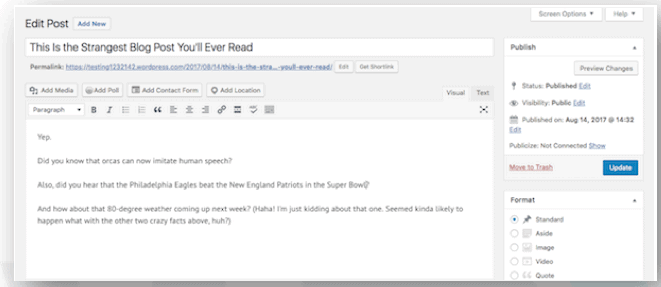Step 7: Publish Your First Website Page
Website Page: There are two types of “pages” you can create for your website:
- Page
These are traditional Website Pages that exist within the main navigation of a site. The About page, Contact page, and individual services pages all are made using the Page feature in WordPress
- Post
These are blog post “pages” that will only exist within the blog on your website unless you designate the home page to serve as the blog feed.

Now, the great thing about WordPress is that the interface is consistent regardless of whether you’re creating a website page or a post. There are different settings you need to apply to each, but the main area in which you work remains the same, which makes it a workspace that’s easy to get used to.
Of course, if you work in a theme that uses a page builder or a visual builder tool to create content, this is going to look a little different.
Regardless of which content creation tool your WordPress theme uses, it’s time to create content for your site.
If you’re running a blog, simply get started writing your first Posts. Once you hit the Publish button, your blogs will go live on the designated Blog page.
Create some key pages
Before you start writing your posts, it’s a good idea to get your basic pages set up. That way, when you start getting visitors, they’ll have access to more general information about you and your site. This helps your blog look more credible and trustworthy.
The pages I recommend creating first are:
- Home
- Blog
- About
- Contact
- Privacy Policy
- Services ( if applicable )
- Others (when applicable), like Resources, or main pages you want to show in the menu.
Home page
This only applies if you chose to put your posts on a different page. If you opted to have your blog posts on your homepage, you can skip this!
Here how to create a static page, (blog post are going to the blog and not to the front page) if you wish.
Some blogs list their posts on their homepage (or main page).
Other blogs, like mine, have what we call a “static” homepage. (Go to my website homepage to see what I mean.)
A static homepage usually provides an overview of the site and includes a link to the blog (where the posts are listed), as well as links to other parts of the website.
Sidenote: In some instances, you might want a static site without blog posts at all. In that case, create pages and be done.
Now that you know the difference, what do you want on your homepage? Blog posts or a static page?
You can customize how you want your Homepage by going in the Menu into your WordPress dashboard and click on Appearance. Then follow the instructions.
Blog page
To check if you have a blog page already, go to Pages > All Pages.
If your homepage is a static page, and you need a blog page, go to Pages > Add New. Title it “Blog” or something similar. Do not type anything in the post window.
Hit Publish.
Additionally if you write a blog post, automatically goes into your blog’s page.
About page
Your About page is one of the essential parts of your site and is often one of the most visited pages. It is a crucial website page. I did not like initially to appear on my blog, but then I found myself when I went online to look at other bloggers about page. Then I realize how important it is.
It’s also one of the first places a visitor goes to decide whether or not your blog is worth their time. Writing a good one is essential.
Make sure a visitor will know within the first few lines of your About page how your site will help them. They’ll want to understand why they should stick around. But of course, they also want to know who you are and how you got there.
Then, once you’ve told them why they should read, next show them what to read. Anticipate what a new visitor would want to know. Provide links to other pages on your site (once you have them, of course).
Contact page
Providing contact information to your visitors is essential. Blogging is a form of social media, and building relationships is critical.
Privacy Policy page
These days, privacy is important to us all. Having a privacy policy is important.
Go to Settings > Privacy to get more information and start creating your Privacy Policy page. You can use the drafted page already set up for you as a template, or you can use a generator like this one or this one.
Other Pages
The following are additional pages you might consider creating, although you could hold off on them until you get a tiny bit further along in the process. But you are a business and have a product already; you may want to have a service page.
- Tools I Use/Resources: Many of your readers will appreciate a list of the tools and resources you use and recommend. Additionally, this is an excellent source of affiliate income.
- Service page: this is the page where you offer your services if you have one.
- Email list signup page /Newsletter: These pages are used when someone signs up for your email list. I highly recommend them.
- Disclosure Policy. When you start making money, you must have a disclosure policy. You can use a disclosure policy generator like this one to create this page when you’re ready.

“Let’s Interact: Write me a question if you have one, or ask anything”
